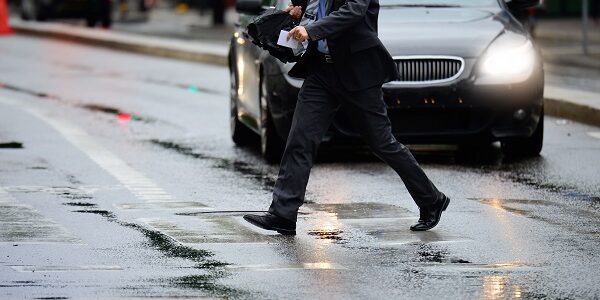Legally speaking, a “pedestrian” refers to anyone walking on foot, using a motorized or non-motorized wheelchair or mobility device, horse and buggy operators and passengers, horse riders, skiers, and skaters.
It’s generally safe to assume that pedestrians have the right of way in most circumstances, but there are a few laws that dictate where pedestrians should and should not travel.
Pedestrians should use sidewalks where present and crosswalks to cross at intersections, but where there is no sidewalk present, they should travel against traffic on the left side of a road. Pedestrians should follow WALK/DON’T WALK signals at crosswalks, but if the signal changes while crossing, the pedestrian maintains the right of way and traffic must yield. Any pedestrian crossing outside of a crosswalk in an intersection must yield the right of way to approaching traffic, and pedestrians should not cross an intersection at a diagonal to avoid having to cross the street twice.
Can a Pedestrian Be At Fault?
We tend to assume that when a car hits a pedestrian, the driver is at fault. But if a person is violating pedestrian traffic laws, they may be found at fault.
Crossing outside of a crosswalk, or jaywalking, gives drivers less time to react. Pedestrians can be at- fault for an accident if they were jaywalking when the collision happened.
Similarly, stepping into traffic unexpectedly or suddenly increases the likelihood of a collision with a car. A pedestrian who enters traffic suddenly could be found at- fault or partially at- fault for an accident.
Pedestrians who ignore signs, warnings, or barriers such as those along a highway are putting themselves at risk of a collision and at risk of being held liable.
Pedestrians who are distracted – using a cell- phone, wearing headphones, etc. – or who are under the influence of alcohol or drugs can also be at- fault for a collision with a car. Failing to remain vigilant, having impaired judgment, and/or unpredictable behavior all increase the likelihood of an accident, and a pedestrian may be held liable.
If you’ve been in a collision with a pedestrian, you should document the facts to the best of your ability, avoid admitting fault, and contact a car accident lawyer.
What If Someone Walks In Front of Your Car?
Ideally, you’ll have enough time to stop or swerve to avoid colliding with a pedestrian, but if a collision happens, you should:
- Stop and assist
- Call 911 to report the accident and the pedestrian’s injuries
- Document: take photos of the scene, the victim, and the victim’s injuries
- Do not admit fault
- Call a car accident lawyer
If you accidentally hit a pedestrian with your car, liability depends on whether you were at fault or not. To avoid legal consequences or a complicated case, call our experienced attorneys at Kajy Law for a free consultation.
Types of Damages
Victims of car accidents can be compensated for their injuries and losses through economic, non- economic, and exemplary damages. Your attorney will ask for medical records, receipts, and other relevant documents to prove you qualify for compensation and win your case.
Economic damages compensate victims for specific costs such as personal property damage, medical expenses, lost wages, or the cost of hiring a caretaker or home aid.
Non- economic damages refer to losses that can’t be measured monetarily such as lost quality of life, emotional pain and suffering, disfigurement or disability, or mental health issues related to the accident, such as PTSD.
Call Kajy Law Today
Kajy Law’s team of Detroit car accident lawyers and paralegals possess a complete understanding of state and federal laws pertaining to Michigan car accidents and a thorough knowledge of how to handle insurance companies to create the best outcome possible for our clients.
If you’ve been in a car accident with a pedestrian, call 877-KAJY- CARES or contact us to schedule a free consultation.






